The Pennsylvania Railroad, legal name The Pennsylvania Railroad Company, also known as the "Pennsy", was an American Class I railroad that was established in 1846 and headquartered in Philadelphia. It was named for the commonwealth in which it was established. At its peak in 1882, the Pennsylvania Railroad was the largest railroad, the largest transportation enterprise, and the largest corporation in the world.
Locomotive classification on the Pennsylvania Railroad took several forms. Early on, steam locomotives were given single-letter classes. As the 26 letters were quickly assigned, that scheme was abandoned for a more complex system. This was used for all of the PRR's steam locomotives, and — with the exception of the final type bought — all electric locomotives also used this scheme.

The Pennsylvania Railroad (PRR) K4 4-6-2 "Pacific" was its premier passenger-hauling steam locomotive from 1914 through the end of steam on the PRR in 1957.
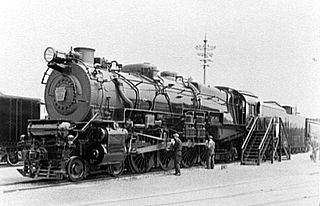
The M1 was a class of steam locomotive of the Pennsylvania Railroad (PRR). It was a class of heavy mixed-traffic locomotives of the 4-8-2 "Mountain" arrangement, which uses four pairs of driving wheels with a four-wheel guiding truck in front for stability at speed and a two-wheel trailing truck to support the large firebox needed for sustained power. Although built for both passenger and freight work, they spent most of their service lives hauling heavy high-speed freight trains. Many PRR men counted the M1 class locomotives as the best steam locomotives the railroad ever owned.

The Pennsylvania Railroad (PRR) class T1 duplex-drive 4-4-4-4 steam locomotives, introduced in 1942 with two prototypes and later in 1945-1946 with 50 production examples, were the last steam locomotives built for the PRR and arguably its most controversial. They were ambitious, technologically sophisticated, powerful, fast and distinctively streamlined by Raymond Loewy. However, they were also prone to wheelslip both when starting and at speed, in addition to being complicated to maintain and expensive to run. The PRR decided in 1948 to place diesel locomotives on all express passenger trains, leaving unanswered questions as to whether the T1's flaws were solvable, especially taking into account that the two prototypes did not have the problems inherent to the production units.

The Pennsylvania-Reading Seashore Lines was a railroad that operated in South Jersey in the 20th century. It was created in 1933 as a joint consolidation venture between two competing railroads in the region: the Pennsylvania Railroad and the Reading Company.

The PRR S1 class steam locomotive was a single experimental duplex locomotive of the Pennsylvania Railroad. It was designed to demonstrate the advantages of duplex drives espoused by Baldwin Chief Engineer Ralph P. Johnson. It was the longest and heaviest rigid frame reciprocating steam locomotive that was ever built. The streamlined Art Deco styled shell of the locomotive was designed by Raymond Loewy.
The Pennsylvania Railroad's class P5 comprised 92 mixed-traffic electric locomotives constructed 1931–1935 by the PRR, Westinghouse and General Electric. Although the original intention was that they work many passenger trains, the success of the GG1 locomotives meant that the P5 class were mostly used on freight. A single survivor, prototype #4700, is at the National Museum of Transportation in St Louis, Missouri.

The Pennsylvania Railroad's class O1 comprised eight experimental boxcab electric locomotives built in 1930 and 1931. They were built in preparation for the New York to Washington Electrification project. They had the wheel arrangement classified as 4-4-4 in the Whyte notation. Although successful, they were not powerful enough for the railroad's increasingly heavy trains. For production, the PRR chose to concentrate on the P5 class, effectively an enlarged and more powerful version of the O1 with an additional pair of driving wheels.
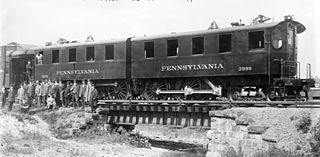
The Pennsylvania Railroad DD1 was a class of boxcab electric locomotives built by the Pennsylvania Railroad. The locomotives were developed as part of the railroad's New York Tunnel Extension, which built the original Pennsylvania Station in New York City and linked it to New Jersey via the North River Tunnels. The Pennsylvania built a total of 66 locomotives in its Altoona Works; they operated in semi-permanently coupled pairs. Westinghouse supplied the electrical equipment.
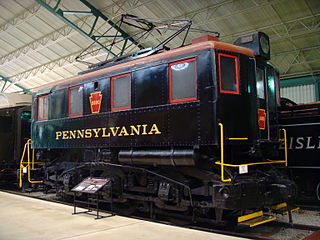
The Pennsylvania Railroad's class B1 comprised 42 electric switcher locomotives built between 1926 and 1935. They were of 0-6-0 wheel arrangement in the Whyte notation with 700 horsepower. As built, the first 28 locomotives in the 1926 order formed semi-permanently coupled pairs grouped in three classes.
Class E6 on the Pennsylvania Railroad was the final type of 4-4-2 "Atlantic" locomotive built by the railroad, and second only to the Milwaukee Road's streamlined class A in size, speed and power. Although quickly ceding top-flight trains to the larger K4s Pacifics, the E6 remained a popular locomotive on lesser services and some lasted to the end of steam on the PRR. One, #460, called the Lindbergh Engine, is preserved at the Railroad Museum of Pennsylvania. It was moved indoors to begin preparations for restoration on March 17, 2010. On January 10, 2011, PRR #460 was moved to the museum's restoration shop for a two- to three-year project, estimated to cost $350,000. The engine is listed in the National Register of Historic Places.

Pennsylvania Railroad Class L1s were 2-8-2 "Mikado"-type steam locomotives that were used on the Pennsylvania Railroad during the early twentieth century. These 574 locomotives were manufactured between 1914 and 1919 by the railroad's own Juniata Shops as well as the Baldwin Locomotive Works (205) and the Lima Locomotive Works (25).
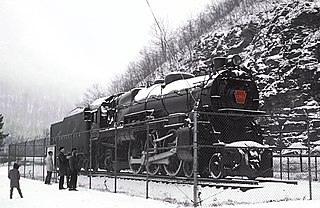
Pennsylvania Railroad 1361 is a 4-6-2 K4 "Pacific" type steam locomotive built in May 1918 by the Pennsylvania Railroad's (PRR) Juniata Shops in Altoona, Pennsylvania. It hauled mainline passenger trains in Pennsylvania and commuter trains in Central New Jersey on the PRR until its retirement from revenue service in 1956. Restored to operating condition for excursion service in 1987, No. 1361 and its only surviving sister locomotive, No. 3750, were designated as the official state steam locomotives by the Pennsylvania General Assembly. In 1988, it was sidelined due to mechanical problems and was currently owned by the Railroaders Memorial Museum (RMM) in Altoona, Pennsylvania, who were currently attempting to return No. 1361 back to operation.

The Pennsylvania Railroad's MP54 was a class of electric multiple unit railcars. The class was initially constructed as an unpowered, locomotive hauled coach for suburban operations, but were designed to be rebuilt into self-propelled units as electrification plans were realized. The first of these self-propelled cars were placed in service with the PRR subsidiary Long Island Rail Road with DC propulsion in 1908 and soon spread to the Philadelphia-based network of low frequency AC electrified suburban lines in 1915. Eventually the cars came to be used throughout the railroad's electrified network from Washington, D.C. to New York City and Harrisburg, Pennsylvania.
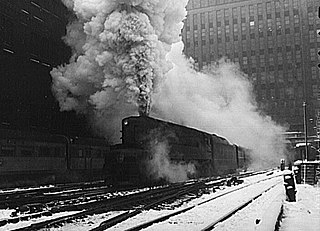
The Manhattan Limited was a passenger train of the Pennsylvania Railroad which served the Chicago—New York City route.
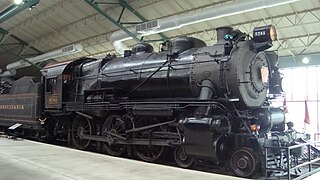
The Pennsylvania Railroad G5 is a class of 4-6-0 steam locomotives built by the PRR's Juniata Shops in the mid-late 1920s. It was designed for passenger trains, particularly on commuter lines, and became a fixture on suburban railroads until the mid-1950s. The G5 was the largest and most powerful 4-6-0 locomotive, except for a single Southern Pacific 4-6-0 that outweighed it by 5,500 lb.

The Pennsylvania Railroad's class A5s was the largest class of 0-4-0 steam locomotives. The Pennsylvania Railroad built 47 in its Juniata Shops between 1916–1924. They were all retired by 1957. One is preserved at the Railroad Museum of Pennsylvania.
The Pennsylvania Railroad's class K29s comprised a single experimental 4-6-2 "Pacific" type steam locomotive. Constructed by Alco-Schenectady, it was given road number 3395. Although only one demonstrator was constructed, the K29s would become the basis for the highly successful K4s Pacifics and L1s Mikados. The lone example spent most of its life on the PRR's Pittsburgh division main line and was retired around 1929.















